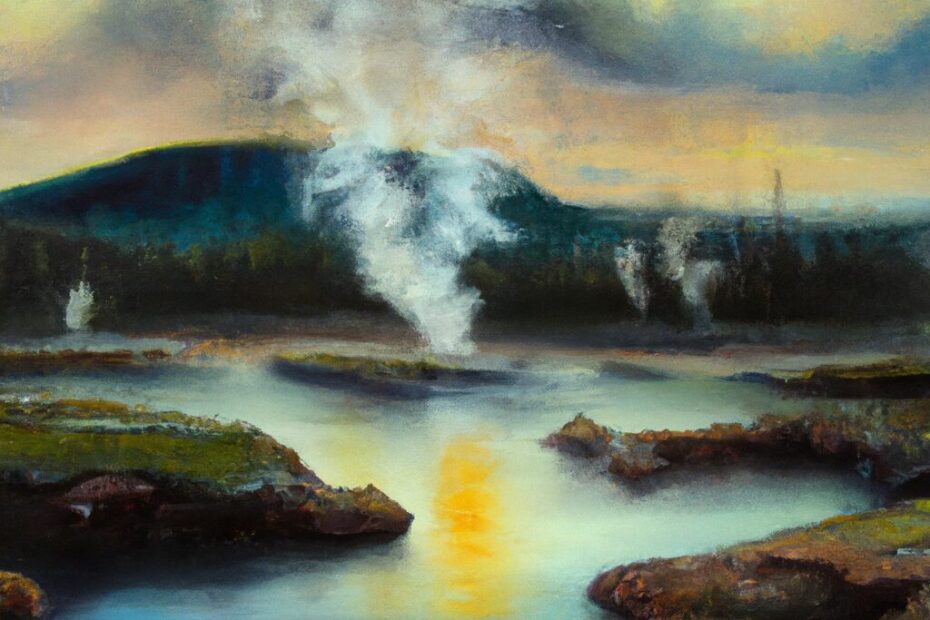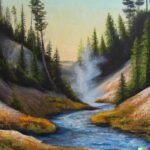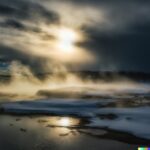Riverside Geyser, located in Yellowstone National Park, is a spectacular natural wonder that captivates visitors with its powerful eruptions. But what exactly is Riverside Geyser and how did it get its name? In this article, we will explore the eruption pattern, history, and surrounding area of Riverside Geyser.
From the best time to visit to nearby hiking trails, we will cover everything you need to know to fully experience this fascinating geyser. So, let’s dive in and uncover the secrets of Riverside Geyser!
What is Riverside Geyser?
Riverside Geyser is a prominent geothermal feature located in Yellowstone National Park, known for its spectacular eruptions and proximity to the iconic Old Faithful geyser.
Geysers like Riverside are a common sight in this area due to the region’s high geothermal activity. The unique aspect of Riverside Geyser lies in its beautiful setting along the Firehole River, where its eruptions can reach up to 75 feet in height, captivating visitors with its natural splendor. The proximity of Riverside Geyser to Old Faithful creates a fascinating dynamic, showcasing the diversity and vibrancy of the thermal features that make Yellowstone National Park a geological wonderland.
Where is Riverside Geyser Located?
Riverside Geyser is situated within the captivating landscapes of Yellowstone National Park, amidst a geothermal wonderland teeming with geysers and volcanic features.
The geyser is located along the banks of the Firehole River in the Upper Geyser Basin, offering visitors a unique experience of witnessing its eruptions against the backdrop of lush forests and colorful hot springs. Surrounding Riverside Geyser, one can find diverse geothermal features such as bubbling mud pots, steaming fumaroles, and majestic geysers like Old Faithful. The area showcases the raw power of the Earth’s geological forces, with the geyser’s eruptions reaching heights of up to 75 feet, creating a spectacular display of water, steam, and mineral deposits.
How Did Riverside Geyser Get Its Name?
The name Riverside Geyser derives from its proximity to the Firehole River, aligning with the geyser’s geological connection to the surrounding hydrothermal phenomena in Yellowstone’s landscape.
Situated along the banks of the Firehole River, Riverside Geyser stands as a testament to the intricate interplay between water, heat, and rock that manifests in Yellowstone’s geothermal wonders. The geyser’s name not only reflects its location but also highlights the fundamental role that water plays in the eruption cycles of geysers.
Riverside Geyser’s eruptions, characterized by graceful bursts shooting up to 75 feet in the air, captivate visitors with their blend of natural beauty and scientific marvel.
What is the Eruption Pattern of Riverside Geyser?
Riverside Geyser follows a distinct eruption pattern characterized by regular intervals, impressive eruption heights, and captivating displays of thermal activity that vary in duration.
Visitors to Yellowstone National Park are often mesmerized by the reliable performance of Riverside Geyser. Eruptions typically occur every 6 to 8 hours, making it one of the more predictable geysers in the park. During its eruptions, Riverside Geyser can reach heights of up to 75 feet, sending plumes of hot water and steam into the air. The duration of each eruption varies, with some lasting just a few minutes while others can continue for over 20 minutes. This variability in both height and duration adds to the excitement and allure of observing Riverside Geyser’s geothermal spectacle.
How Often Does Riverside Geyser Erupt?
The eruption of Riverside Geyser occurs at regular intervals, providing a predictable and mesmerizing display for visitors exploring the geysers in the park’s thermal areas.
This consistency in the eruption frequency of Riverside Geyser is a testament to its reliable nature, drawing crowds of eager spectators who anticipate its breathtaking displays. The geyser’s rhythmic outbursts have become a celebrated spectacle within Yellowstone National Park, captivating both seasoned geologists and casual tourists alike. As one waits in anticipation for the next eruption, there’s a sense of excitement and wonder that fills the air, creating a unique and magical experience in the heart of the park’s thermal regions.
What is the Duration of Riverside Geyser’s Eruption?
The eruption of Riverside Geyser exhibits varying durations, ranging from moments of intense activity to extended spectacles that showcase the geyser’s unique behavior.
During shorter eruptions, Riverside Geyser bursts forth with sudden energy, propelling powerful jets of water and steam into the air. These brief outbursts create a sense of anticipation, as spectators witness the geyser’s raw power unleashed in a concentrated burst.
In contrast, longer eruptions unfold gradually, with the geyser maintaining a steady display of cascading water that gracefully dances in the sunlight. This extended show captivates onlookers with its mesmerizing rhythm, showcasing the geyser’s dynamic range of activity behaviors and the awe-inspiring beauty of nature at work.
How High Does Riverside Geyser Erupt?
Riverside Geyser achieves impressive eruption heights, creating a breathtaking spectacle that showcases the geyser’s power and allure, drawing in visitors from across Yellowstone to witness its grandeur.
During its eruptions, Riverside Geyser can soar to heights of over 75 feet, sending powerful bursts of scalding hot water and steam into the air. The sight of the geyser towering above the Firehole River against the backdrop of the lush forest is truly mesmerizing. As the water cascades back down, it creates a magical mist that adds to the enchanting aura of the surrounding landscape, making it a must-see for nature enthusiasts and photographers alike.
What is the History of Riverside Geyser?
The history of Riverside Geyser is intertwined with the geological evolution of Yellowstone and the enduring presence of geothermal wonders that characterize the region as a geological marvel in the United States.
Formed through centuries of geological processes, Riverside Geyser stands as a testament to the immense power and beauty of nature. Its intermittent eruptions, often reaching heights that captivate onlookers, showcase the relentless energy simmering beneath the Earth’s surface. As one of the many geothermal features dotting Yellowstone National Park, this geyser serves as a reminder of the dynamic forces shaping the landscape. The breathtaking display of steam and water spouting into the air is not just a spectacle but a window into the Earth’s remarkable geology.
When Was Riverside Geyser Discovered?
Riverside Geyser was discovered during the early exploration of Yellowstone, unveiling a hidden gem amidst the diverse geologic features and geothermal activity that define the park’s natural splendor.
As explorers ventured into the wilderness of Yellowstone in the late 19th century, they were awe-struck by the steamy spectacles and bubbling cauldrons that dotted the landscape. Amidst this dramatic backdrop, Riverside Geyser stood out with its majestic eruptions that send scalding water shooting into the air against a backdrop of towering pines and rugged cliffs. Its discovery added another layer of wonder to the already enchanting tapestry of geothermal wonders that Yellowstone had to offer, cementing its reputation as a must-see destination for nature enthusiasts and adventurers alike.
Has Riverside Geyser Ever Had a Major Eruption?
While Riverside Geyser has displayed notable eruptions, it has yet to experience a major volcanic event, remaining a captivating but stable fixture among Yellowstone’s rare geothermal features within the volcanic hot spot.
Throughout its history, Riverside Geyser has been known for its impressive displays, with eruptions reaching heights of up to 75 feet, captivating visitors with its powerful bursts of steam and water. The geyser’s activity has been carefully monitored over the years, revealing patterns and fluctuations in eruption frequency. Despite occasional variations, Riverside Geyser has maintained a remarkable level of predictability, making it a favored attraction for tourists and scientists alike who seek to witness the beauty and precision of nature’s geothermal wonders.
What is the Surrounding Area Like?
The area surrounding Riverside Geyser is a mesmerizing landscape dotted with geysers, hydrothermal features, and scenic vistas that showcase the raw beauty and geologic wonders of Yellowstone.
Neighboring geysers like Morning Glory Pool and Old Faithful complement the mystical aura of Riverside Geyser, creating a harmonious symphony of nature’s elements. The bubbling hot springs, vibrant colored bacterial mats, and the occasional bubbling mud pots add a surreal touch to the landscape, enhancing the ever-changing canvas of Yellowstone’s geologic beauty. As steam rises in the background against the backdrop of towering pine forests and distant mountain peaks, visitors are transported to a world where nature’s forces reign supreme, leaving a lasting impression of awe and admiration.
What Other Geysers are Nearby?
Adjacent to Riverside Geyser, visitors can explore a diverse array of geysers, each presenting a unique geologic wonder and showcasing the dynamic forces of Yellowstone’s captivating geothermal phenomena.
From the powerful eruptions of Castle Geyser to the tranquil beauty of Morning Glory Pool, the geysers in this area offer a range of experiences.
Castle Geyser stands out with its towering cone and infrequent but impressive eruptions, while Morning Glory Pool captivates with its stunning blue waters and intricate microbial mats.
Features like Beauty Pool and Artemisia Geyser add to the tapestry of thermal attractions, each with its own blend of colors, shapes, and thermal activity.
These geysers collectively contribute to Yellowstone’s status as a hotbed of geologic fascination and natural beauty.
Are There Any Hiking Trails Near Riverside Geyser?
Explorers can venture along scenic hiking trails near Riverside Geyser, immersing themselves in the natural beauty of Yellowstone while encountering thermal wonders, including enchanting hot springs.
These trails provide a perfect blend of adventure and serenity, leading hikers through diverse landscapes featuring bubbling mud pots, colorful bacterial mats, and hissing steam vents.
Along the way, visitors can witness the awe-inspiring power of nature as they pass by the iconic Old Faithful geyser. The variety of trails caters to all levels of hikers, from leisurely strolls to more challenging treks that offer panoramic views of the surrounding geothermal features.
This unique combination of natural beauty and geological phenomena makes hiking near Riverside Geyser an unforgettable experience for nature enthusiasts.
How Can Visitors View Riverside Geyser?
Visitors can witness the awe-inspiring eruptions of Riverside Geyser from designated viewing areas, soaking in the sights and sounds of one of Yellowstone’s most enchanting geothermal attractions amidst the park’s natural beauty.
As visitors stake out their spots on the benches and boardwalks around Riverside Geyser, they are treated to a front-row seat to nature’s powerful spectacle. The geyser’s eruptions, reaching up to 75 feet high, are not just visually captivating but also a symphony of bubbling water and steam. The optimal vantage points allow visitors to feel the intensity of the geyser’s energy as it reverberates through the ground beneath their feet, creating a truly immersive encounter with Yellowstone’s geothermal wonders.
Is There a Specific Time of Day to See Riverside Geyser?
The best time to observe Riverside Geyser’s eruptions is during daylight hours, allowing visitors to fully appreciate the grandeur of this geothermal spectacle amid the backdrop of Yellowstone’s natural wonders.
Visiting Riverside Geyser during the day provides optimal lighting conditions to capture the dazzling play of water and steam against the picturesque Yellowstone landscape. The sun’s rays dance on the geyser’s spout, creating a mesmerizing display that showcases nature’s raw power. Daytime visits offer better visibility, allowing visitors to witness every detail of the eruption without any hindrance. The vibrant colors of the surrounding geothermal features are also more vivid during daylight, enhancing the overall experience of exploring this unique corner of Yellowstone National Park.
Is There a Best Season to Visit Riverside Geyser?
The ideal season to visit Riverside Geyser is in the warmer months when the accessibility to nearby thermal pools and geothermal vents enhances the overall experience of exploring this natural wonder within Yellowstone.
During the warmer months, visitors can fully immerse themselves in the unique geologic features present in Yellowstone, such as the colorful hot springs and diverse range of microbial mats that bloom in the sunshine. The lush greenery surrounding Riverside Geyser adds to the picturesque setting, creating a tranquil environment that is perfect for picnics or simply soaking in the natural beauty. Warmer temperatures make it more comfortable for hiking the trails leading to Riverside Geyser and observing the fascinating geothermal activity that shapes this fascinating region of Yellowstone National Park.
Last Updated on February 8, 2024 by Jon Waraas – Originally Posted: February 8, 2024

I’m Jon Waraas, and I’ve been navigating the online world since 2006. By day, I’m the proud owner of some eCommerce gems, and by night, I’m the voice behind the adventures on Waraas.Com.
My heart, however, belongs to the wild beauty of Yellowstone National Park. I’ve got a collection of websites dedicated to sharing the wonders of this natural masterpiece. Oh, and did I mention? I’m currently building my own cabin inside the ghost town of Gilmore, Idaho – a cabin with tales to tell!
When I’m not immersed in the digital realm, you’ll find me lacing up my boots for a good hike or setting up camp under the star-studded sky.




